
The 3rd Marine Aircraft Wing is the major west coast aviation unit of the United States Marine Corps. It is headquartered at Marine Corps Air Station Miramar, in San Diego, California and provides the aviation combat element for I Marine Expeditionary Force. The wing is made up of a headquarters squadron, four flying groups, an aviation command and control group and an aviation engineering group.
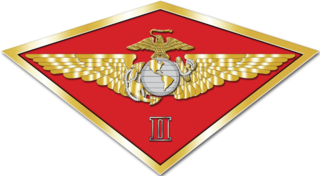
The 2nd Marine Aircraft Wing is the major east coast aviation unit of the United States Marine Corps and is headquartered in Marine Corps Air Station Cherry Point, North Carolina. The Wing provides the aviation combat element for the II Marine Expeditionary Force.
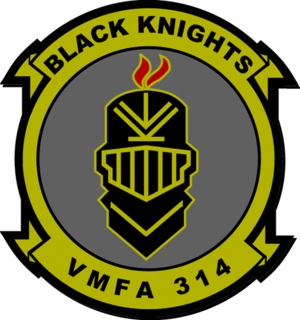
Marine Fighter Attack Squadron 314 (VMFA-314) is a United States Marine Corps F-35C Lightning II squadron. The squadron, known as the "Black Knights", is based at Marine Corps Air Station Miramar, California and falls under the command of Marine Aircraft Group 11 (MAG-11) and the 3rd Marine Aircraft Wing, but deploys with the US Navy's Carrier Air Wing Nine (NG).
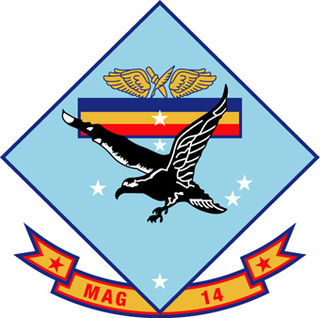
Marine Aircraft Group 14 (MAG-14) is a United States Marine Corps aviation unit based at Marine Corps Air Station Cherry Point, North Carolina that is currently composed of four AV-8B Harrier squadrons, one F-35C squadron, one UAV squadron, one KC-130 squadron, and an aviation logistics squadron.

Marine Aircraft Group 31 (MAG-31) is a United States Marine Corps aviation group based at Marine Corps Air Station Beaufort, South Carolina that is currently composed of two F/A-18C Hornet squadrons, one F/A-18A++ Hornet squadron, two F/A-18D Hornet squadrons, one F-35B Lightning II training squadron, an aviation logistics squadron, and a wing support squadron. It falls under the command of the 2nd Marine Aircraft Wing.
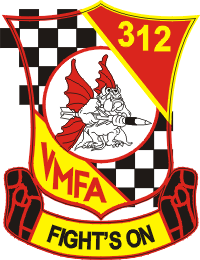
Marine Fighter Attack Squadron 312 (VMFA-312) is a United States Marine Corps F/A-18C Hornet squadron. Also known as the "Checkerboards", the squadron is based at Marine Corps Air Station Beaufort, South Carolina and falls under the command of Marine Aircraft Group 31 (MAG-31) and the 2nd Marine Aircraft Wing. The Radio Callsign is "Check."

Marine Aircraft Group 32 (MAG-32) was a United States Marine Corps aviation unit established during World War II.
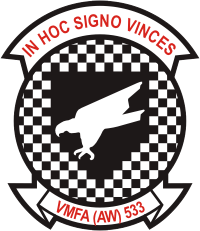
Marine All-Weather Fighter Attack Squadron 533 is a United States Marine Corps F/A-18 Hornet squadron. Also known as the "Hawks", the squadron is based at Marine Corps Air Station Beaufort, South Carolina and falls under the command of Marine Aircraft Group 31 (MAG-31) and the 2nd Marine Aircraft Wing.
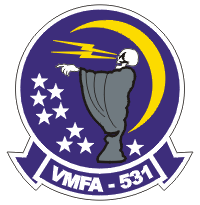
Marine Fighter Attack Squadron 531 (VMFA-531) was a United States Marine Corps fighter squadron consisting of F/A-18 Hornets. Known as the "Grey Ghosts”, the squadron participated in action during World War II and the Vietnam War. They were decommissioned on March 27, 1992.

Marine Air Control Squadron 1 (MACS-1) is a United States Marine Corps aviation command and control squadron. The squadron provides aerial surveillance, air traffic control, ground-controlled intercept, and aviation data-link connectivity for the I Marine Expeditionary Force. It was the first air warning squadron commissioned as part of the Marine Corps' new air warning program and is the second oldest aviation command and control unit in the Marine Corps. The squadron is based at Marine Corps Air Station Yuma and falls under Marine Air Control Group 38 and the 3rd Marine Aircraft Wing.
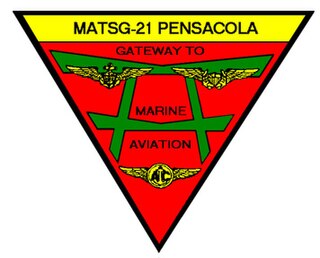
Marine Aviation and Training Support Group 21 (MATSG-21) is a United States Marine Corps aviation training group that was originally established in 1922 as the 2nd Aviation Group. During World War II the unit was known as Marine Aircraft Group 21 (MAG-21). Squadrons from MAG-21 fought in many of the opening battles of the war to include the Battle of Wake Island, Battle of Midway and as part of the Cactus Air Force during the Battle of Guadalcanal The group was deactivated following the end of the war and was not reactivated until 2000 when the Marine Aviation Detachment at Naval Air Station Pensacola, Florida was renamed MATSG-21. The core of the MATSG personnel is derived from 175 officer instructors and 550 student naval aviators/naval flight officers.
Marine Aircraft Group 93 (MAG-93) was a United States Marine Corps aviation group established during World War II. MAG-93, a dive bombing training group, was commissioned on 1 April 1944 and was initially headquartered at Marine Corps Auxiliary Airfield Bogue, North Carolina. Their mission was to train pilots to fly the Curtiss SB2C Helldiver. The group was decommissioned in October 1945 as part of the post-war drawdown of forces and has been inactive since.

Marine Aviation and Training Support Group 33 (MATSG-33) is a United States Marine Corps aviation training group that was originally established during World War II as Marine Aircraft Group 33 (MAG-33). Fighter squadrons from MAG-33 fought most notably during the Battle of Okinawa and also as the first Marine aviation units to support the Korean War when they arrived as part of the 1st Provisional Marine Brigade. They helped stabilize the United Nations positions during the Battle of Pusan Perimeter and fought in Korea for the remainder of the war. At some point in the 1960s, the group was deactivated and was not reactivated until 2000, when Marine Aviation Training Support Group at Naval Air Station Oceana, Virginia was renamed MATSG-33.
Marine Aircraft Group 53 (MAG-53) was a United States Marine Corps night fighter training group that was commissioned during World War II. It was the first night-fighter group in the Marine Corps. During the course of the war the group trained eight night fighting squadrons and sent seven of them into combat. The group was decommissioned after the war during the post-war drawdown of forces.
Marine Fighting Squadron 413 (VMF-413) was a fighter squadron of the Marine Forces Reserve during the Cold War. It descended from bombing squadron VMB-413, which was the Marine Corps' first medium bomber squadron and had fought during World War II. Best known as “Night Hecklers” and the “Shamrocks”, the squadron fought in many areas of the Pacific War.

Marine Air Control Squadron 7 (MACS-7) was a United States Marine Corps aviation command and control squadron. The squadron provided aerial surveillance and ground-controlled interception and saw action most notably during the Battle of Okinawa in World War II and the Vietnam War. They were last based at Marine Corps Air Station Yuma and fell under the command of Marine Air Control Group 38 (MACG-38) and the 3rd Marine Aircraft Wing.

Robert O. Bisson was a brigadier general in the United States Marine Corps who served in both World War II and the Korean War. A naval aviator and communications engineer, he was at the forefront of the Marine Corps' use of radar for early warning and fighter direction. In 1943, as a member of VMF(N)-531, he supervised the installation and operation of the Marine Corps' first ground-controlled interception (GCI) equipment utilized in a combat zone. During the Battle of Okinawa he commanded the headquarters responsible for coordinating the Marine Corps' ground-based air defense units.
Marine Aircraft Group 43 (MAG-43) was a fixed wing aviation group in the United States Marine Corps Reserve based at Naval Air Station Joint Reserve Base Willow Grove, Pennsylvania.
Marine Air Defense Command 1 (MADC-1) was a United States Marine Corps aviation command and control unit based in Okinawa, Japan. Originally commissioned in April 1944 as Marine Aircraft Group 62 (MAG-62), the higher headquarters for new PBJ squadrons that were training on the east coast of the United States. In late 1944, MAG-62 was tasked with joining the 2nd Marine Aircraft Wing on Okinawa to serve as an additional headquarters element for all of the disparate forces that fell under the command of the Tactical Air Force, Tenth Army. On August 15, 1945, MAG-62 was re-designated as Marine Air Defense Command 1. MADC-1 was a short lived unit that was decommissioned on November 30, 1945, shortly after the surrender of Japan.















